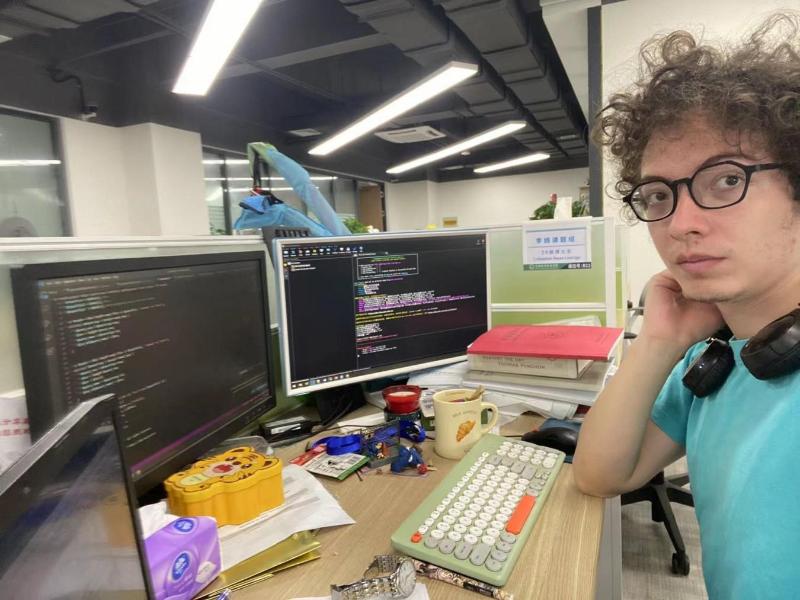Christopher Reyes Loáiciga (王凯飞) was born in the Centro American nation of Costa Rica. He graduated from the School of Biology and soon after, seeking for opportunities to continue his studies, found a golden chance in the intersection between two of his interests, Chinese culture and biology, when he applied to study in SJTU for a master degree in Bioinformatics. After getting his degree, having found himself in love with the country, the campus, and the research area, he did not hesitate in applying for the Ph.D. program where now he keeps studying in his hectic third year.
From the field to China and to the computers
His small country, Costa Rica, almost in the other side of the globe, is located in the space between the warm tropical belts of the world, making it a green place brimming with natural diversity. This perhaps influenced, perhaps not (but will surely become important later), that he can recall early memories rife with his fascination for birds, fish, the growth of plants and overall, the secrets of life. The truth is that, growing up with desires to established himself on a scientific area, he decided, even before graduating from high school, that he would focus on the field of biology. There he studied for four years, visiting jungles, swamps, mountain summits and plains that dot his country, the complex classifications of life, the never-ending connections between organisms deep in wild ecosystems, the often not very intuitive mechanisms hidden in the, not less wild, systems of the cell and that make us and all the other creatures of this world tic. Along his curriculum classes, unbeknownst, as all, of the future, he took extra courses in foreign languages, Chinese and Japanese. After graduating, he was informed of the cooperation between his university and the Chinese Embassy in Costa Rica. After this, one plus one can be put together and what happened next can be deduced…
The area of bioinformatics
…One thing however, may be less expected. Having largely dedicated himself for what can be called pure biology, studying half the time in wet labs, the other half in field work, somedays wearing a lab coat, somedays wearing tall boots deep in salt water or muddy beaches, he decided to change some gears and study the fast and relatively new area of bioinformatics which applies the increasing power and importance of computational tools to study biological data.
Coming to China, his first option was SJTU as it is one of the top universities, not only locally, but globally. After hours of research online, reading who knows how many professors profiles, he decided to contact professor 李婧 from the School of Life Sciences and Biotechnology. This decision proved soon to be one of the best in his life.
Research and days in the lab
In his lab, they specialize on the analysis of proteomic data, i.e., the detection of proteins expressed by organisms, which can be applied to multiple areas, such as the diversity of microorganisms in unexplored sites, the function that these proteins perform or even how complex diseases such as cancer work, providing clues for treatments. Internationally, the first complete proteome map of human lung adenocarcinoma was completed (Cell 2020), and it was selected for 'China's Important Medical Advances of 2020' and 'Shanghai Science and Technology Progress Report 2020'. During his masters, he studied the interaction between bacteria that coexist inside us and that together comprise the human gut microbiota. Those important partners we all harbor inside us have become recently a hot topic, since they play a crucial role on our health. His research was focused on how this complex set of organisms comprise a network. He used the expression of the proteins in the microbiota to measure how each is related to each other, therefore, building a co-expression network. This network was applied to measure the relationship between closely connected sequences and tried multiple algorithms to predict what is the most probable function for each of the sequences.
For his ongoing doctoral research, he has been focusing, this time, instead, not on the expression of proteins in the human gut, but on the proteins coded by fungi, specifically on the baker’s yeast. He explored those proteins that are 100 amino acids or less in length, since they have been neglected in favor of larger sequences and as its functionality was previously unknown. In his researched he compared the sequences with multiple organisms related (and not so related) to find out the evolutionary origin of those small proteins and how they come to be and stay on the fungi genomes. This was the first step in which he based his next and current projects, allowing him to build a model of the “life cycle” of these mysterious sequences.
Although much work is done in Li Labs group, also a lot of fun is had. During his years of master degree, each semester the group would organize a trip to different parts of China around Shanghai such as Suzhou or Hangzhou.
The future
Already in the second half of his four years pressure amounts however research is always enjoyable as new things are discovered every day and new challenges rises begging for interesting solutions to be discovered. After graduation, Christopher expects to find new opportunities in China to continue his career. Here, the colorful culture and endless novel experiences keeps him always optimistic about live.




